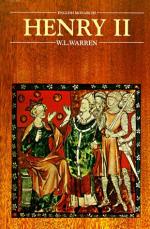or priesthood. He refused indeed to join in any
fanatical outbreak of persecution of the Jews, such
as Philip of France consented to; and when persecution
raged against the Albigenses of the south he would
have no part or lot in it, and kept his own dominions
open as a refuge for the wandering outcasts; but this
may well have been by the counsel of the wise churchmen
about him. To the last he looked on the clergy
as his best advisers and supporters. He never
demanded tribute from churches or monasteries, a monkish
historian tells us, as other princes were wont to
do on plea of necessity; with religious care he preserved
them from unjust burthens and public exactions.
By frequent acts of devotion he sought to win the
favour of Heaven or to rouse the religious sympathies
of England on his behalf. In April 1177 he met
at Canterbury his old enemy, the Archbishop of Reims,
and laid on the shrine of St. Thomas a charter of
privileges for the convent. On the 1st of May
he visited the shrine of St. Eadmund, and the next
day that of St. Aetheldreda at Ely. The bones
of a saint stolen from Bodmin were restored by the
king’s order, and on their journey were brought
to Winchester that he might do them reverence.
Relics discovered by miraculous vision were buried
with pomp at St. Albans. Since his vow four years
before at Avranches to build three monasteries for
the remission of his sins, he had founded in Normandy
and England four or five religious houses for the
Templars, the Carthusians, and the Austin canons;
he now brought nuns from Fontevraud, for whom he had
a special reverence, and set them in the convent at
Amesbury, whose former inhabitants were turned out
to make way for them; while the canons of Waltham
were replaced by a stricter order of Austin canons.
A templar was chosen to be his almoner, that he might
carry to the king the complaints of the poor which
could not come to his own ears, and distribute among
the needy a tenth of all the food and drink that came
into the house of the king.
It is true that on Henry himself the strife with the
Church left deep traces. He became imperious,
violent, suspicious. The darker sides of his
character showed themselves, its defiance, its superstition,
its cynical craft, its passionate pride, its ungoverned
wrath. His passions broke out with a reckless
disregard of earlier restraints. Eleanor was a
prisoner and a traitor; she was nearly fifty when he
himself was but forty-one. From this time she
practically disappeared out of Henry’s life.
The king had bitter enemies at court, and they busied
themselves in spreading abroad dark tales; more friendly
critics could only plead that he was “not as
bad as his grandfather.” After the rebellion
of 1174 he openly avowed his connection with Rosamond
Clifford, which seems to have begun some time before.
Eleanor was then in prison, and tales of the maze,
the silken clue, the dagger, and the bowl, were the
growth of later centuries. But “fair Rosamond”




